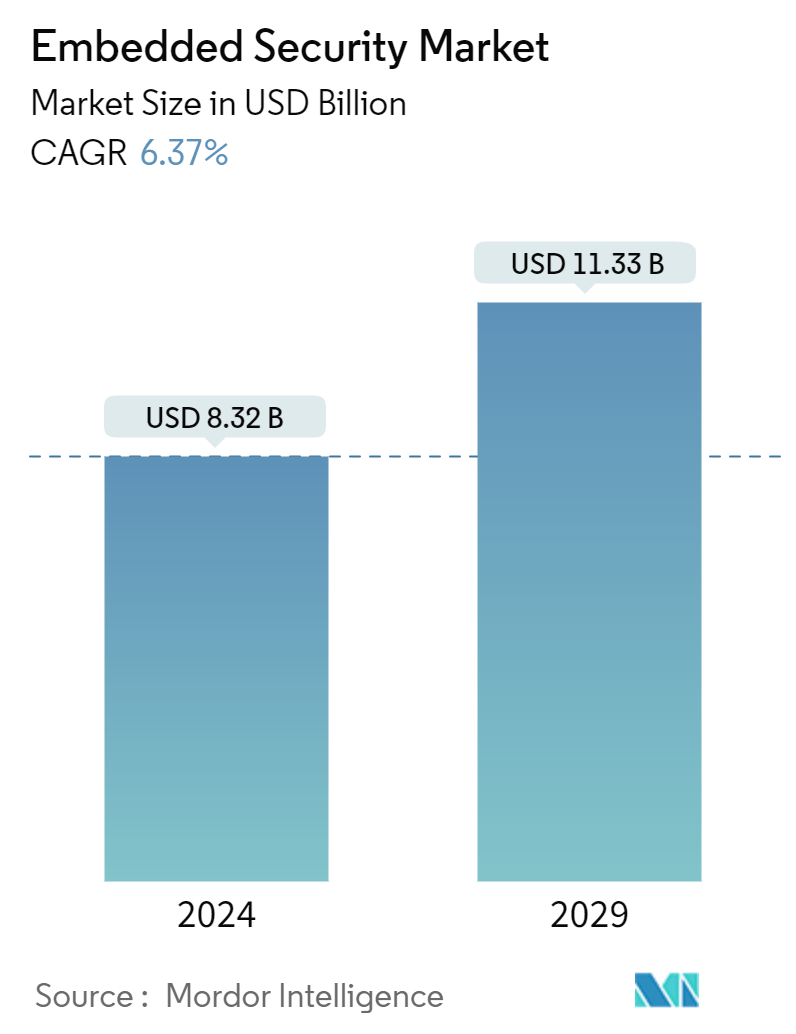Market Size of Embedded Security Industry

| Study Period | 2019 - 2029 |
| Market Size (2024) | USD 8.32 Billion |
| Market Size (2029) | USD 11.33 Billion |
| CAGR (2024 - 2029) | 6.37 % |
| Fastest Growing Market | Asia Pacific |
| Largest Market | North America |
Major Players
*Disclaimer: Major Players sorted in no particular order |
Embedded Security Market Analysis
The Embedded Security Market size is estimated at USD 8.32 billion in 2024, and is expected to reach USD 11.33 billion by 2029, growing at a CAGR of 6.37% during the forecast period (2024-2029).
The increasing need for embedded security solutions in various applications, such as wearables, smartphones and tablets, automotive, smart identity cards, industrial, payment processing and cards, and computers, is driving the growth of this market. Furthermore, the burgeoning Bring Your Own Device (BYOD) trend is boosting global demand for embedded security solutions.
- Embedded security is implemented to safeguard the processing and cardholder data. The usage of embedded security serves to reduce the danger of data breaches, which can result in financial losses and reputational damage. It also aids in meeting the criteria of the Payment Card Industry Data Security Standard (PCI DSS). Secure elements, Trusted Execution Environment (TEE), and tamper-resistant hardware are examples of embedded security used in payment processing and cards. These embedded security solutions prevent cardholder data from being compromised by attackers, among other things.
- Technology is advancing faster than ever before. Every day, technology advances and introduces new approaches and functions. It is not just about computers and mobile applications. It is all about artificial intelligence and IoT-based gadgets, widely employed in everyday human life. The rise of IoT is spreading across all industries as it is utilized in various applications, including industrial automation, healthcare equipment, aviation, wearable technologies, smart home units, and automobiles. The growing use of IoT raises the possibility of different security vulnerabilities with connected devices. This also raises the likelihood of external cyber threats attacking running systems, causing the device to malfunction and cause harm. Also, embedded security devices are on the rise to avoid this condition.
- The market for electric vehicles is constantly evolving and maturing. Customers are aggressively seeking vehicles that do not use traditional fossil fuels. These vehicles should be both cost-effective and environmentally beneficial. Also, to meet these needs, an increasing number of electric charging stations must be established in homes and roadways. The security of charging stations is vital to protect its critical infrastructure. The complicated design and multiple safety concerns in electric vehicles and charging points make managing all security challenges in the system tough. Embedded device security systems help with this problem. Electric vehicle security is critical due to the rising number of embedded and connected software in cars.
- These systems have gained popularity in recent years. However, the basic cost of a single physical security device plus a communication security device is more than the cost of a traditional security system. Internal components like transmitters, receivers, and sensors utilized in security systems are more expensive, directly impacting the system's primary selling price. Furthermore, renewing existing security systems and adopting new integrated technology is not cost-viable for SME enterprises and individual users.
- However, the software itself cannot ensure the security of embedded systems, no matter how sophisticated and security aware. Cloud, software, and hardware vendors must collaborate. For instance, on-chip security features allow robust key management and encryption, which is too computationally demanding for embedded software alone, and hardware technologies secure device boot integrity. Functions like path space control, rootless execution, encrypted file systems, access control rules, and threat-level anomaly detection are made feasible by hardware capabilities and installed in the operating system.
- Furthermore, the Mastercard New Payments Index reported that 94% of Saudi Arabian consumers considered using at least one emerging payment method, such as cryptocurrency, biometrics, contactless, or QR code, in 2022. Furthermore, 68% of respondents reported trying a new payment method, which they would not have under normal circumstances. The COVID-19 pandemic pushed the country's population to try alternative payment methods and reap the benefits of timeliness and convenience. Such developments are expected to impact the market studied positively.
Embedded Security Industry Segmentation
Embedded system security is an approach to protecting software running on embedded systems from attack. It comprises hardware components with a minimal operating system and software provided to end-user industries such as automotive, healthcare, and consumer electronics.
The embedded security market is segmented by component type (hardware, software, and service), application (payment, authentication, content protection, and other applications), end user (automotive, healthcare, consumer electronics, telecommunications, aerospace & defense, and other end users), and geography (North America, Europe, Asia-Pacific, and Rest of the World). The market sizes and forecasts are provided in value (USD) for all the above segments.
| Component Type | |
| Hardware | |
| Software | |
| Service |
| Application | |
| Payment | |
| Authentication | |
| Content Protection | |
| Other Applications |
| End User | |
| Automotive | |
| Healthcare | |
| Consumer Electronics | |
| Telecommunications | |
| Aerospace & Defence | |
| Other End Users |
| Geography | ||||||
| ||||||
| ||||||
| ||||||
|
Embedded Security Market Size Summary
The embedded security market is experiencing significant growth, driven by the increasing demand for security solutions across various applications such as wearables, smartphones, tablets, automotive, smart identity cards, industrial sectors, and payment processing systems. The rise of the Bring Your Own Device (BYOD) trend further amplifies the need for robust embedded security measures. These solutions are crucial in safeguarding processing and cardholder data, thereby reducing the risk of data breaches that can lead to financial losses and reputational damage. The market is also bolstered by advancements in technology, particularly the proliferation of Internet of Things (IoT) devices, which necessitate enhanced security to protect against potential cyber threats. Additionally, the growing electric vehicle market underscores the importance of embedded security in protecting critical infrastructure and ensuring the safety of connected systems.
North America holds a significant share of the embedded security market, driven by increased government intervention and initiatives aimed at protecting critical infrastructure and sensitive data. The market is characterized by intense competition, with major players employing strategies such as product launches, partnerships, and acquisitions to expand their market presence. Recent collaborations and technological advancements, such as those by Infineon Technologies, STMicroelectronics, and Secure-IC, highlight the ongoing innovation in the sector. The market's growth is further supported by the rising adoption of emerging payment methods and the increasing use of wearable devices, which necessitate secure and reliable embedded security solutions. As the demand for these technologies continues to rise, the embedded security market is poised for continued expansion.
Embedded Security Market Size - Table of Contents
-
1. MARKET DYNAMICS
-
1.1 Market Overview
-
1.2 Market Drivers
-
1.2.1 Growing IoT Applications Increasing the Need for IoT Security
-
1.2.2 Adoption of Wearable Devices in Healthcare
-
-
1.3 Market Restraints
-
1.3.1 Low Demand Due to Impact of COVID-19
-
1.3.2 Non-adherence to Government Regulations Due to Lack of Auditing
-
-
1.4 Industry Value Chain Analysis
-
1.5 Industry Attractiveness - Porter's Five Forces
-
1.5.1 Threat of New Entrants
-
1.5.2 Bargaining Power of Buyers/Consumers
-
1.5.3 Bargaining Power of Suppliers
-
1.5.4 Threat of Substitute Products
-
1.5.5 Intensity of Competitive Rivalry
-
-
-
2. MARKET SEGMENTATION
-
2.1 Component Type
-
2.1.1 Hardware
-
2.1.2 Software
-
2.1.3 Service
-
-
2.2 Application
-
2.2.1 Payment
-
2.2.2 Authentication
-
2.2.3 Content Protection
-
2.2.4 Other Applications
-
-
2.3 End User
-
2.3.1 Automotive
-
2.3.2 Healthcare
-
2.3.3 Consumer Electronics
-
2.3.4 Telecommunications
-
2.3.5 Aerospace & Defence
-
2.3.6 Other End Users
-
-
2.4 Geography
-
2.4.1 North America
-
2.4.1.1 United States
-
2.4.1.2 Canada
-
-
2.4.2 Europe
-
2.4.2.1 Germany
-
2.4.2.2 United Kingdom
-
2.4.2.3 France
-
2.4.2.4 Rest of Europe
-
-
2.4.3 Asia-Pacific
-
2.4.3.1 India
-
2.4.3.2 China
-
2.4.3.3 Japan
-
2.4.3.4 Rest of Asia-Pacific
-
-
2.4.4 Rest of the World
-
2.4.4.1 Latin America
-
2.4.4.2 Middle East and Africa
-
-
-
Embedded Security Market Size FAQs
How big is the Embedded Security Market?
The Embedded Security Market size is expected to reach USD 8.32 billion in 2024 and grow at a CAGR of 6.37% to reach USD 11.33 billion by 2029.
What is the current Embedded Security Market size?
In 2024, the Embedded Security Market size is expected to reach USD 8.32 billion.

